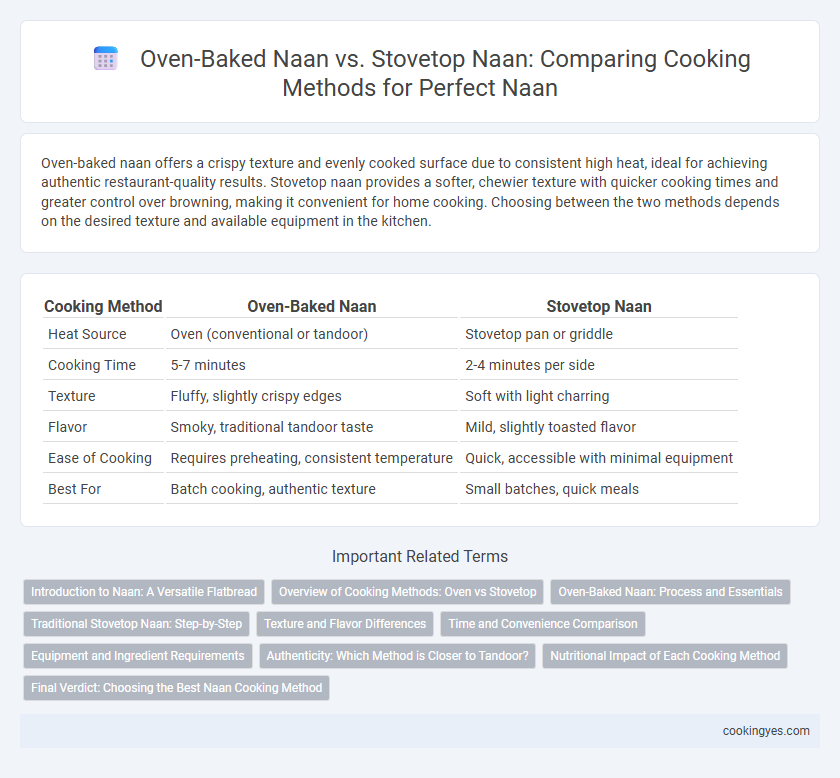Oven-baked naan offers a crispy texture and evenly cooked surface due to consistent high heat, ideal for achieving authentic restaurant-quality results. Stovetop naan provides a softer, chewier texture with quicker cooking times and greater control over browning, making it convenient for home cooking. Choosing between the two methods depends on the desired texture and available equipment in the kitchen.
Table of Comparison
| Cooking Method | Oven-Baked Naan | Stovetop Naan |
|---|---|---|
| Heat Source | Oven (conventional or tandoor) | Stovetop pan or griddle |
| Cooking Time | 5-7 minutes | 2-4 minutes per side |
| Texture | Fluffy, slightly crispy edges | Soft with light charring |
| Flavor | Smoky, traditional tandoor taste | Mild, slightly toasted flavor |
| Ease of Cooking | Requires preheating, consistent temperature | Quick, accessible with minimal equipment |
| Best For | Batch cooking, authentic texture | Small batches, quick meals |
Introduction to Naan: A Versatile Flatbread
Oven-baked naan offers a traditional texture with a slightly crisp exterior and soft, airy interior, achieved by high, consistent heat that mimics tandoor cooking. Stovetop naan provides a quicker, more accessible method, yielding a softer bread with lightly charred spots from direct contact with a hot pan. Both methods enhance the versatility of naan as a flatbread, suitable for pairing with a wide range of dishes from soups to curries.
Overview of Cooking Methods: Oven vs Stovetop
Oven-baked naan achieves a crisp exterior and evenly cooked interior by utilizing consistent high heat, typically between 450degF and 500degF, which replicates traditional tandoor conditions. Stovetop naan, cooked on a hot skillet or tawa, offers quicker preparation and a soft, pliable texture with characteristic charred bubbles, but may require frequent flipping to avoid uneven cooking. Both methods rely on dough hydration and fermentation time to influence softness and flavor, yet oven baking tends to yield a puffier, more authentic naan with slightly smoky undertones.
Oven-Baked Naan: Process and Essentials
Oven-baked naan requires a preheated tandoor or hot oven at temperatures around 500degF (260degC) for crispy, evenly cooked bread with characteristic charred spots. The dough, typically enriched with yogurt and ghee, is rolled thin and slapped onto the oven walls or baked on a hot stone to achieve signature puffiness and texture. Using a high-heat oven ensures faster cooking times and authentic smoky flavors that stovetop methods often struggle to replicate.
Traditional Stovetop Naan: Step-by-Step
Traditional stovetop naan involves cooking the dough directly on a hot griddle or tawa, allowing it to develop characteristic charred spots and a soft, pillowy texture. The process includes rolling the dough into discs, preheating the skillet until very hot, then cooking each naan for a couple of minutes on one side before flipping to achieve even browning and puffiness. This method provides control over heat intensity and results in authentic flavor and texture often preferred in South Asian cuisine.
Texture and Flavor Differences
Oven-baked naan develops a crisp, slightly charred exterior with a soft, airy interior due to high, consistent heat, enhancing its smoky flavor. Stovetop naan tends to have a chewier texture with a more uniform golden-brown surface, preserving a mild, buttery taste. The baking method significantly influences the bread's texture gradient and flavor depth, with ovens providing robust caramelization and stovetops yielding softer, more pliable naan.
Time and Convenience Comparison
Oven-baked naan typically takes 8 to 10 minutes per batch, offering an evenly cooked, fluffy texture with minimal monitoring, making it ideal for larger quantities. Stovetop naan cooks faster, usually 1 to 3 minutes per side, providing quick results but requiring constant attention and flipping. For convenience, oven baking suits batch preparation while stovetop cooking excels in speed and immediate serving needs.
Equipment and Ingredient Requirements
Oven-baked naan requires a tandoor or a conventional oven set to high temperatures, ensuring a charred, airy texture influenced by intense radiant heat, while stovetop naan relies on a heavy skillet or cast-iron pan for direct contact heat to achieve a slightly denser and chewy consistency. Ingredients for both methods typically include flour, water, yeast, yogurt, and oil, but oven baking benefits from a well-hydrated dough to withstand longer cooking times and higher heat. Stovetop preparation often requires a thinner dough and can include additional water-spritzing or butter-brushing for enhanced softness and quick cooking efficiency.
Authenticity: Which Method is Closer to Tandoor?
Oven-baked naan closely mimics the traditional tandoor method by achieving high heat and a smoky char, resulting in an authentic texture and flavor. Stovetop naan, cooked on a griddle or skillet, lacks the intense heat and smoky environment, producing a softer and less charred bread. For those seeking genuine tandoori naan taste, oven baking offers the closest replication outside of a traditional clay oven.
Nutritional Impact of Each Cooking Method
Oven-baked naan typically retains more moisture and develops a slightly crisp exterior, which can reduce oil absorption compared to stovetop naan. Stovetop naan often requires additional butter or oil during cooking, increasing its calorie and fat content. Both methods produce similar carbohydrate and protein profiles, but oven baking generally results in a lower overall fat percentage.
Final Verdict: Choosing the Best Naan Cooking Method
Oven-baked naan offers a smoky, evenly charred texture reminiscent of traditional tandoor-style bread, while stovetop naan provides quick cooking with a softer, pliable texture ideal for immediate serving. Oven baking ensures consistent heat distribution, producing a crisp exterior and fluffy interior, whereas stovetop cooking allows for greater control over browning and puffing through direct contact with a hot pan. Selecting the best naan cooking method depends on desired texture, available equipment, and cooking time, with oven baking favored for authenticity and stovetop preferred for convenience.
Oven-Baked Naan vs Stovetop Naan for Cooking Method Infographic

 cookingyes.com
cookingyes.com